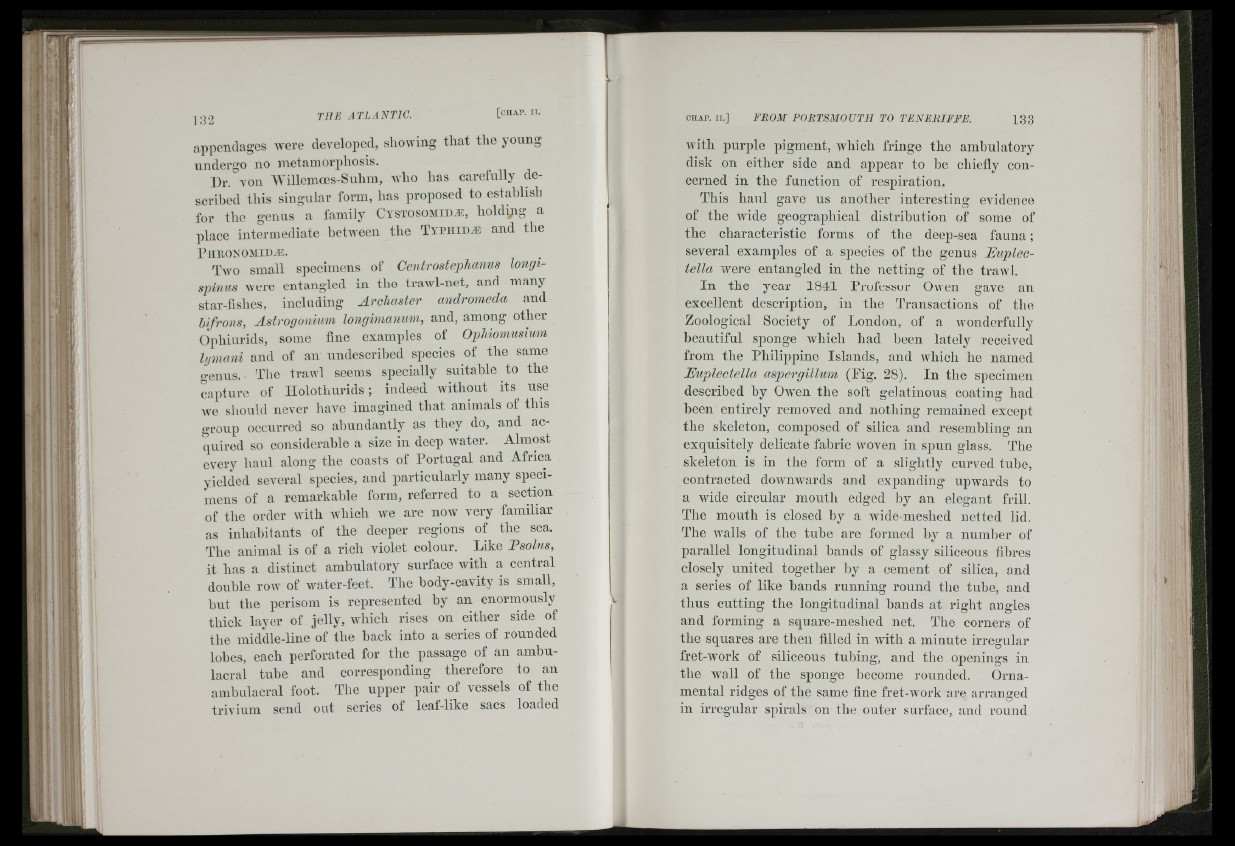
1 3 2 TUE ATLANTIC.
il
g;
appendages were developed, showing that the young
undergo no metamorphosis.
Dr."von AAlllemoes-Snhm, who lias carefully described
this singular form, lias proposed to establish
for the germs a family CYSTOSOMnim, holding a
place intermediate between the TYPiiiuiE and the
P i i iio N O M inm .
Two small specimens of CentrostepJumus longi-
spinus were entangled in the trawl-net, and many
star-fishes, incltiding Archaster andromeda and
Ufrons, Astrogunkm longinianum, and, among other
Ophinrids, some fine examples of Ophiomiisium
hjmani and of an nndescribed species of the same
genus. The trawl seems specially suitable to the
capture of Ilolofhurids; indeed without its use
we sliould never have imagined that animals of this
group occurred so abundantly as they do, and acquired
so considerable a size in deep water. Almost
every haul along the coasts of Portugal and Africa
yielded several species, and particularly many specimens
of a remarkable form, referred to a section
of the order with which we are now very familiar
as inhabitants of the deeper regions of the sea.
The animal is of a rich violet colour. Like Bsolus,
it has a distinct ambulatory surface with a central
double row of water-feet. The hody-cavity is small,
hut the perisom is represented by an enormously
thick layer of jelly, whicli rises on either side of
the middle-line of the hack into a series of rounded
lobes, each perforated for the passage of an ambu-
lacral tuhe and corresponding therefore to an
ambnlacral foot. The upper pair of vessels of the
trivium send ont series of leaf-like sacs loaded
1 3 3
with purple pigment, which fringe the ambulatory
disk on either side and appear to be chiefly concerned
in the function of respiration.
This haul gave us another interesting evidence
of the wide geographical distribution of some of
the characteristic forms of tbe deep-sea fauna;
several examples of a species of the genus Euplectella
were entangled in the netting of tbe trawl.
In the year 1841 Professor Owen gave an
excellent description, in the Transactions of the
Zoological Society of London, of a wonderfully
beautiful sponge which bad been lately received
from the Philippine Islands, and which he named
Eupleclella aspergillum (Pig. 28). In the specimen
described by Owen the soft gelatinous, coating had
been entirely removed and nothing remained except
the skeleton, composed of silica and resembling an
exquisitely delicate fabric woven in spun glass. The
skeleton is in the form of a slightly curved tube,
contracted dowmvards and expanding upwards to
a wide circular month edged by an elegant frill.
The mouth is closed by a wide-meshed netted lid.
The walls of the tube are formed by a number of
parallel longitudinal bands of glassy siliceous fibres
closely united together by a cement of silica, and
a series of like bands running round the tube, and
thus cutting the longitudinal bands at right angles
and forming a square-meshed net. The corners of
the squares are then filled in with a minute irregular
fret-work of siliceous tuliing, and the openings in
the v^all of the sponge become rounded. Ornamental
ridges of the same fine fret-work are arranged
in irregular spirals on the outer surface, and round
' i
Ii:
i - : v
-
!
i|ik’
-tIeil-] /,: '.